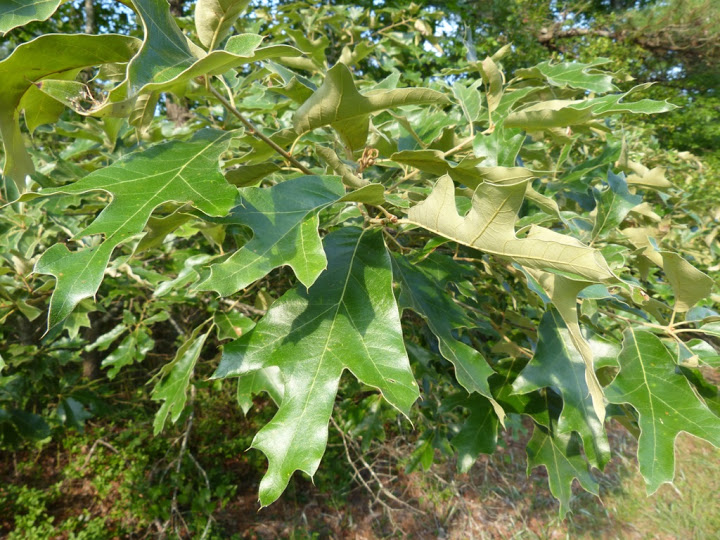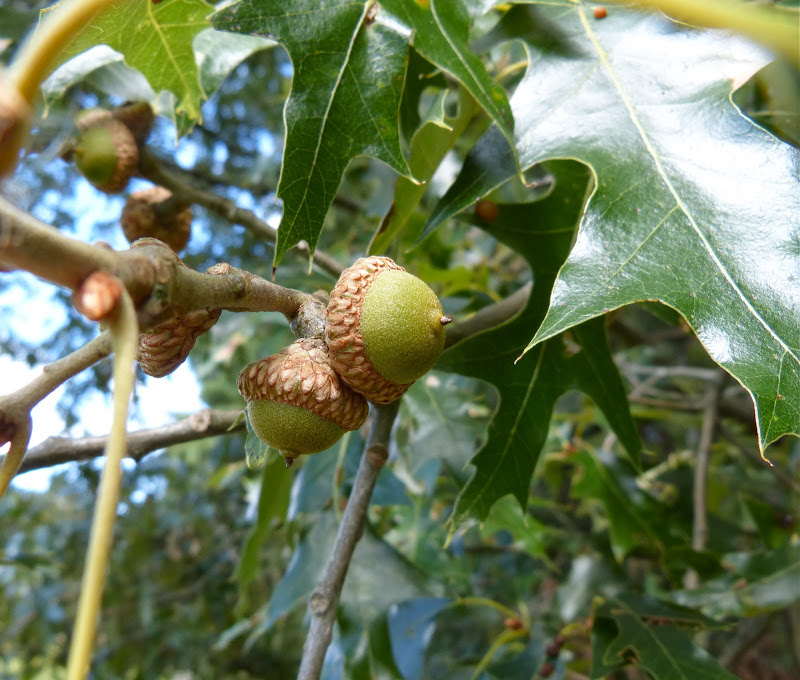Southern Red Oak
Quercus falcata Michx.
Description
Southern red oak trees (beech family, Fagaceae) are tall and have straight trunks which develop branches that spread out and give the tree a rounded look at the top. These trees grow to 70 and 80 feet¹. The leaves of southern red oak are 5 to 9 inches long¹. They are dark green on the upper surface with a brown, hairy underside. Leaves have round bases and 3 to 5 bristle- tipped lobes². The lower lobes of the tree are long and narrow which distinguishes them from other red oaks². Leaves often have sinuous curve in the midvein. During the fall, leaves droop and turn a reddish color. The bark of southern red oaks is dark brownish-black with deep grooves. Flowers are produced in the spring and are unisexual with male catkins and female clusters³. Acorns are single or in pairs and mature in the fall months³. They are 0.5 inches long and brown with the cup covering one-third of the nut. Acorns need two seasons to mature, in the second season of autumn is when they ripen4. Acorns have a high tannin content to discourage herbivory and germinate in the spring after overwintering on the ground13.

Southern red oak leaves. @ J. Brighton 2015, Maryland Biodiversity Project11
Mature acorns of southern red oak. @ J. Brighton 2013, Maryland Biodiversity Project11
Distribution
Southern red oaks are found primarily in the southeastern part of the United States¹. They occur from southern New Jersey and Ohio down to northern Florida and out west to Texas and Oklahoma¹. Southern red oaks grow well in poor quality upland soils³. They can be planted in residential areas and along the roads³. In Maryland southern red oaks occur in on the eastern and western shores of the Chesapeake Bay and on the Piedmont along the Fall Line11.

Native distribution of southern red oak. USDA12
Wildlife Importance
Many species of animals use southern red oak as a source of food including squirrels, songbirds, deer, turkey, and black bears¹. It is also a host for many insects such as the wide variety of butterfly species5. Southern red oaks also provide nesting places for mammals and birds.
Economic importance
The wood of the southern red oak is a very important source of timber¹. Due to its solid root system and large size it is useful in watershed protection¹. It is also used for furniture and construction materials¹. Southern red oak also has tannins which allows for leather processing¹.
Threats
Defoliation is a big problem for southern red oak. Caterpillars and fall cankerworms are the main reason for the defoliation5. The gypsy moth (Lymantria dispar) also has become a potential problem for the southern red oak. In feeding trials, the tree becomes defoliated with a 20% survival rate13. In oaks specifically, there is a lack of regeneration because of the competition of non-native species6. Oak wilt is a fungal disease that is also a threat.
Interesting Facts
- Deciduous oak trees native to the eastern United States can live a long life. Southern red oak trees can live to be 275 years7.
- Another common name for southern red oak trees is Spanish oak. They may be called Spanish oak because they are native to areas of the country where the first Spanish colonies were found8.
- The National Champion Southern red oak is in Sussex County, Virginia9. It measures 321 inches in circumference and is 92 feet tall9. Maryland’s State Tri- Champion is in Leonardtown and it has a circumference of 255 inches (last measures in 2012)10.
References
- University of Florida 4-H Forest Ecology: Southern red oak
- Wikipedia: Quercus falcata
- University of Florida Landscape Plants: Quercus falcata
- Missouri Department of Conservation: Southern red oak
- North Carolina State Extension: Quercus falcata
- Center for Invasive Species Prevention: Threats to America’s magnificent oaks
- SFGATE: Life span for oak trees
- Lady Bird Johnson Wildflower Center: Quercus falcata
- Monumental Trees: Quercus falcata
- Maryland State Champion Trees
- Maryland Biodiversity Project: Southern red oak
- USDA-Forest Service Silvics Vol. 2 Hardwoods: Quercus falcata
- USDA-Forest Service Fire Effects Information System: Quercus falcata
Contributed by Y. Varma and M. Tran

